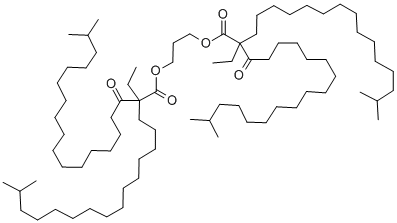Ethyl 2-acetylcaprylate
- CAS NO.:29214-60-6
- Empirical Formula: C12H22O3
- Molecular Weight: 214.3
- MDL number: MFCD00026889
- EINECS: 249-518-0
- SAFETY DATA SHEET (SDS)
- Update Date: 2024-12-18 14:15:32

What is Ethyl 2-acetylcaprylate?
Physical properties
Colorless slightly oily liquid. Very slightly soluble in water, soluble in akohol, miscible with oils.
Occurrence
Has apparently not been reported to occur in nature.
Preparation
By the alkylation of ethyl acetoacetate with hexyl bromide or by any other suitable method. Uses: In public use since the 1950s. Use in fragrances in the USA amounts to approximately 10001b/yr.
Production Methods
Ethyl 2-acetylcaprylate can be produced by condensation of Ethyl acetate and Hexyl acetate, using Sodium ethoxide catalyst.
Synthesis Reference(s)
Journal of the American Chemical Society, 64, p. 580, 1942 DOI: 10.1021/ja01255a035
Properties of Ethyl 2-acetylcaprylate
| Boiling point: | 149 °C / 25mmHg |
| Density | 0.94 |
| refractive index | 1.4320 to 1.4360 |
| FEMA | 4459 | ETHYL 2-ACETYLOCTANOATE |
| form | clear liquid |
| pka | 11.89±0.59(Predicted) |
| color | A colourless slightly oily liquid. |
| Odor | at 100.00 %. methyl dihydrojasmonate fruity jasmin waxy herbal |
| JECFA Number | 1958 |
| CAS DataBase Reference | 29214-60-6(CAS DataBase Reference) |
| EPA Substance Registry System | Octanoic acid, 2-acetyl-, ethyl ester (29214-60-6) |
Safety information for Ethyl 2-acetylcaprylate
| Signal word | Warning |
| Pictogram(s) |
 Exclamation Mark Irritant GHS07 |
| GHS Hazard Statements |
H227:Flammable liquids H315:Skin corrosion/irritation H319:Serious eye damage/eye irritation H335:Specific target organ toxicity, single exposure;Respiratory tract irritation |
| Precautionary Statement Codes |
P210:Keep away from heat/sparks/open flames/hot surfaces. — No smoking. P261:Avoid breathing dust/fume/gas/mist/vapours/spray. P264:Wash hands thoroughly after handling. P264:Wash skin thouroughly after handling. P271:Use only outdoors or in a well-ventilated area. P280:Wear protective gloves/protective clothing/eye protection/face protection. P302+P352:IF ON SKIN: wash with plenty of soap and water. P305+P351+P338:IF IN EYES: Rinse cautiously with water for several minutes. Remove contact lenses, if present and easy to do. Continuerinsing. P332+P313:IF SKIN irritation occurs: Get medical advice/attention. P337+P313:IF eye irritation persists: Get medical advice/attention. P370+P378:In case of fire: Use … for extinction. P405:Store locked up. P403+P233:Store in a well-ventilated place. Keep container tightly closed. P403+P235:Store in a well-ventilated place. Keep cool. P501:Dispose of contents/container to..… |
Computed Descriptors for Ethyl 2-acetylcaprylate
New Products
4-Fluorophenylacetic acid 4-Methylphenylacetic acid N-Boc-D-alaninol N-BOC-D/L-ALANINOL Tert-butyl bis(2-chloroethyl)carbamate 3-Morpholino-1-(4-nitrophenyl)-5,6-dihydropyridin- 2(1H)-one Furan-2,5-Dicarboxylic Acid Tropic acid S-2-CHLORO PROPIONIC ACID ETHYL ISOCYANOACETATE 2-Bromo-1,3-Bis(Dimethylamino)Trimethinium Hexafluorophosphate (6-METHYL-[1,3]DITHIOLO[4,5-b]QUINOXALIN-2-ONE INDAZOLE-3-CARBOXYLIC ACID 4-IODO BENZOIC ACID (2-Hydroxyphenyl)acetonitrile 4-Bromopyrazole 5,6-Dimethoxyindanone 2-(Cyanocyclohexyl)acetic acid 4-methoxy-3,5-dinitropyridine 2-aminopropyl benzoate hydrochloride 1-(4-(aminomethyl)benzyl)urea hydrochloride diethyl 2-(2-((tertbutoxycarbonyl)amino) ethyl)malonate tert-butyl 4- (ureidomethyl)benzylcarbamate Ethyl-2-chloro((4-methoxyphenyl)hydrazono)acetateRelated products of tetrahydrofuran








You may like
-
 Ethyl 2-Hexylacetoacetate CAS 29214-60-6View Details
Ethyl 2-Hexylacetoacetate CAS 29214-60-6View Details
29214-60-6 -
 Ethyl 2-acetylcaprylate 95% CAS 29214-60-6View Details
Ethyl 2-acetylcaprylate 95% CAS 29214-60-6View Details
29214-60-6 -
 1975-50-4 98%View Details
1975-50-4 98%View Details
1975-50-4 -
 2-HYDROXY BENZYL ALCOHOL 98%View Details
2-HYDROXY BENZYL ALCOHOL 98%View Details
90-01-7 -
 2-Chloro-1,3-Bis(Dimethylamino)Trimethinium Hexafluorophosphate 221615-75-4 98%View Details
2-Chloro-1,3-Bis(Dimethylamino)Trimethinium Hexafluorophosphate 221615-75-4 98%View Details
221615-75-4 -
 61397-56-6 CIS BROMO BENZOATE 98%View Details
61397-56-6 CIS BROMO BENZOATE 98%View Details
61397-56-6 -
 14714-50-2 (2-Hydroxyphenyl)acetonitrile 98+View Details
14714-50-2 (2-Hydroxyphenyl)acetonitrile 98+View Details
14714-50-2 -
 118753-70-1 98+View Details
118753-70-1 98+View Details
118753-70-1
Statement: All products displayed on this website are only used for non medical purposes such as industrial applications or scientific research, and cannot be used for clinical diagnosis or treatment of humans or animals. They are not medicinal or edible.